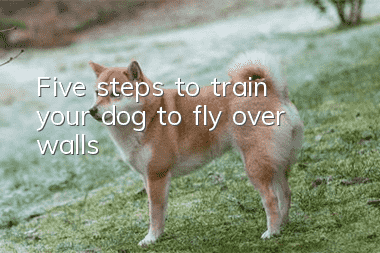Five steps to train your dog to fly over walls

When you hear the name, you may think it is impossible to achieve. This kind of skill training is generally required for training police dogs. When tracking bad guys, dogs must overcome any obstacles and pursue them no matter where the criminal attempts to escape. Sometimes it is necessary to climb over obstacles such as walls. There is obviously a completely different difference between climbing over and jumping over a wall. If a low wall blocks the way, the dog can naturally get over it with a slight jump. In this case, the dog's jumping body is usually completely higher than the top of the wall. But if it encounters a high wall, the dog has no choice but to put its paws up and turn over to the other side. How different parts of the muscles and bones exert force can be trained in different ways. There are two types of wall climbing. One is permanent, sealed on the ground with cement, but the height can be adjusted at any time, making construction and maintenance more convenient. The other is movable and non-height-adjustable. It looks like an A-shape when viewed from one side; the overall height can be changed by adjusting the inclination with the ground.
Training goal: Teaching a dog the stunt of flying over walls and climbing over walls has an additional benefit, which is to enhance the dog’s self-confidence. It must firmly believe that he is a good guy who can face difficulties and solve problems. The previous excessive shyness will be greatly improved, which is good for both you and it. The most critical test of this training is the dog's physical strength, but it doesn't hurt to put a little more thought into it. If you find the trick, it's even easier than you think.
Suitable age: 5 months-8 months
Applicable dog breeds: all dog breeds
Equipment: traction rope | collar | obstacle wall | snacks
Level: Middle school (improvement)-Sports skills training
Training cycle: 15 minutes*15 times
Steps to train a dog to “fly over the roof and walk over walls”:
Step 1: If your dog is similar to an adult German Shepherd or Doberman Pinscher, you can start by building a wall about 152 cm high without any padding on the back. You stand to the right of the dog, with the dog in a squatting position with the collar and leash around its neck, about 180 cm away from the wall. Use an encouraging and high-spirited tone to tell it what to do, and be sure to arouse its spirit. A sleepy dog cannot climb over the wall. You can jog in place and say cheerfully: "Are you ready? We're about to start. I know you can do it."
Step 2:Although it is impossible to understand what you want it to do, it must also enter a state of excitement. With a command of "go", he quickly rushed towards the wall. As you get closer to the wall, lift the leash up in your hand, and use this pulling force to tell the dog to jump! This commandIt is the secret signal to hold the leash in the left hand and ask the dog to jump up. Wait for it to land on its back and praise it well. But be careful to check to see if the rope chain is wrapped around the wall. The praise you give must be timely. As long as the leash is not completely relaxed, the moment the dog lands on the ground it will definitely hurt - any other details interspersed at this time can easily be misunderstood by the dog. So when you make sure that the chain is fine, praise him warmly - what a good guy! You are indeed my good buddy! I knew you were fine!
Step 3:Then practice again from the same direction. Don't give your dog time to make a decision, otherwise he will definitely go around rather than over. If it has this thought, tighten the rope chain to stop it from saying "it's not right". As the height of the wall increases, the more strength you need to control the situation and the greater your dog's tendency to be lazy. On the first day of training, it is enough to let the dog turn over five times, but the last time must ensure the standard action. Never call it a day after an unsuccessful climb, even if you have to do it all over again. If your dog keeps making mistakes over and over again, you should review your methods. Ultimately it’s up to you whether you can let your dog climb over it. If you can't do that, you might as well go inside and take some vitamins. Your dog is not naturally inclined to climb over walls, so you must convey to him that you are capable of climbing over them.
Step 4: When training, slowly increase the difficulty, and don’t become fat in one go. For example, after your dog has successfully climbed a 150-centimeter-high wall 12 times, add a layer of boards to the top. 10 cm the first time and 5 cm each time thereafter. As you gain altitude, reduce the number of climbs to seven, then slowly increase to twelve. Of course, if its comprehension and execution capabilities are not high, you can speed it up as appropriate. It is easier to mark on the brick board, so you can know the specific height at a glance.
Step 5:If the dog can always climb over the 173 cm wall, the effect will be quite gratifying. If it can continue to increase to 180 cm, it will be really not simple. The standard of police dog training is just to climb this height. If you want to go for the ultimate effect, you can also add slats to the top of the wall, which will also increase the height of the wall. Generally speaking, if the dog can climb over 180 centimeters, the slats need to be nailed. If you are using an A-frame wall, simply turn the angle toward 90 degrees. Come on, it's impossible to be absolutely vertical, the wall is already set up that way.
Things to note when training your dog to fly over walls:
1. The skill of dogs climbing over walls has been trained for many years.Observation and research have revealed no serious injuries so far. Dogs can be taught how to use their bodies and abilities to mitigate impacts and protect themselves.
2. Since your dog is not for police or military use, we can greatly reduce the difficulty. The ground level on the other side of the wall you build for your dog must be at least half the total height.
3. On the first day of training, it is enough to let the dog turn over 5 times, but the last time must ensure the standard movement. Never call it a day after an unsuccessful climb, even if you have to do it all over again.
4. When the dog completes the action, don’t forget to encourage it immediately.
- What should you pay attention to when raising a husky? A guide to raising a husky!
- Taboos for dogs to eat
- 4 Reasons to Neuter Your Pet
- Treating Rheumatism in Schnauzers
- Why is the dog’s belly purple?
- What is the normal weight of an adult golden retriever?
- What are the signs that a dog is insecure? What are the signs that a dog is insecure?
- How long does it usually take for a dog to recover from a broken leg before he can walk normally?
- Can Teddy fungus be cured?
- What to do if your dog has tear stains_What causes tear stains in dogs!



